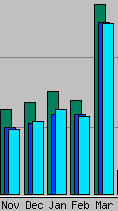Atlanta, GA…CDC’s National Center on Birth Defects and Developmental Disabilities has been tracking ASDs for over a decade through the Autism and Developmental Disabilities Monitoring (ADDM) Network. The newest estimates from the ADDM Network are based on data collected in 14 areas of the United States during 2008. These 14 communities comprised over eight percent of the United States population of 8-year-olds in 2008. Information was collected on children who were 8 years old because previous work has shown that, by this age, most children with ASDs have been identified for services.
CDC estimates 1 in 88 children (11.3 per 1,000) has been identified with an autism spectrum disorder (ASD).
 This marks a 23% increase since our last report in 2009. And, a 78% increase since our first report in 2007. Some of the increase is due to the way children are identified, diagnosed and served in their local communities, although exactly how much is due to these factors in unknown.
This marks a 23% increase since our last report in 2009. And, a 78% increase since our first report in 2007. Some of the increase is due to the way children are identified, diagnosed and served in their local communities, although exactly how much is due to these factors in unknown.- The number of children identified with ASDs varied widely across the 14 ADDM Network sites, from 1 in 47 (21.2 per 1,000) to 1 in 210 (4.8 per 1,000).
- ASDs are almost 5 times more common among boys (1 in 54) than among girls (1 in 252).
- The largest increases over time were among Hispanic children (110%) and black children (91%). We suspect that some of this increase is due to greater awareness and better identification among these groups. However, this finding explains only part of the increase over time, as more children are being identified in all groups.
- There were increases over time among children without intellectual disability (those having IQ scores above 70), although there were also increases in the estimated prevalence of ASDs at all levels of intellectual ability.
- More children are being diagnosed at earlier ages—a growing number of them by age 3. Still, most children are not diagnosed until after they reach age 4, even though early identification and intervention can help a child access services and learn new skills. This is why CDC’s Learn the Signs. Act Early. program is essential. Through this program, CDC provides free tools to help parents track their child’s development and free resources for doctors and educators. CDC is also working with states and communities to improve early identification.
- CDC also provided leadership in establishing Healthy People 2020 objectives
 and supporting the American Academy of Pediatrics recommendation
and supporting the American Academy of Pediatrics recommendation that all children be screened by age 2, because early screening and diagnosis improve access to services during a child’s most critical developmental period.
that all children be screened by age 2, because early screening and diagnosis improve access to services during a child’s most critical developmental period.


Understanding Risk Factors and Causes
CDC knows that people want answers to what is causing the increase in the number of children identified with ASDs and so do we. To find out what is causing ASDs, we need to better understand the risk factors. The search for risk factors is a prominent, rapidly growing field of research. Each year, the Interagency Autism Coordinating Committee![]() reviews study findings to help direct the national research agenda for ASDs. CDC’s work is a key part of this larger, coordinated effort.
reviews study findings to help direct the national research agenda for ASDs. CDC’s work is a key part of this larger, coordinated effort.
Most scientists who study ASDs believe there is no single cause. Studies suggest that both genetic and non-genetic factors play a role in developing an ASD. Studies also suggest the following:
- Children born to older parents are at slightly higher risk.
- A small percentage of children who are born prematurely or with low birth weight are at greater risk for having ASDs.
- Some harmful drugs taken during pregnancy have been linked with a higher risk of ASDs; for example, the prescription drugs thalidomide and valproic acid.
Study to Explore Early Development (SEED)
SEED is currently the largest study in the United States to help identify what might put children at risk for ASDs. It is being conducted by CDC’s Centers for Autism and Developmental Disabilities Research and Epidemiology (CADDRE). SEED is studying potential risk factors that may be related to genes, health conditions and other events during the mother’s pregnancy and the child’s first few years of life. So far, SEED has enrolled more than 3,700 children, and more than 2,200 children and their parents have completed the study.
Read more about the SEED study methods >>
Learn the Signs. Act Early.
The “Learn the Signs. Act Early.” program aims to change perceptions about the importance of identifying developmental concerns early and gives parents and professionals the tools to help.
From birth to 5 years, children reach milestones in how they play, learn, speak and act. A delay in any of these areas could be a sign of an ASD or other developmental disabilities.
- CDC provides free materials to help parents and early educators track young children’s developmental milestones, tips
 [PDF – 5.10MB] for encouraging children’s growth and development, and information about what to do if there’s a concern about a child’s development. There are also free resources for health professionals.
[PDF – 5.10MB] for encouraging children’s growth and development, and information about what to do if there’s a concern about a child’s development. There are also free resources for health professionals. - National, state and local programs that serve parents of young children can add “Learn the Signs.” materials to their resources for parents. Programs can customize CDC’s materials with their own contact information and distribute them to the populations they serve.
CDC also works with representatives from public health, medicine, education, and advocacy organizations in every state to improve early identification, screening, and referral practices so children and their families can get the services and support they need.
CDC partners with the Health Resources and Services Administration, the Association of University Centers on Disabilities, the Association of Maternal and Child Health Programs and other partners in the delivery of this program.
Looking Back, Moving Forward
Through CDC’s work in ASDs over the past 15 years, we know more about which children are more likely to have ASDs, at what age they are likely to be diagnosed, and whether progress has been made in diagnosing children with ASDs early. This is the information communities need to plan for services and understand where improvements can be made to help children.
Although there are still many unanswered questions about what causes ASDs and how to treat them, the data tell us one thing with certainty—there are more children and families that need help. The emotional and financial toll on families and communities is staggering. Therapy costs alone run in the thousands, costs that are beyond the reach of many families.
CDC is committed to the important work of understanding ASDs—committed to tracking ASDs, committed to research to identify risk factors and causes, and committed to developing resources that help identify children with ASDs as early as possible—so that children can get the help they need.
More Information
- Article: Prevalence of Autism Spectrum Disorders, 2008
- Community Report
 [PDF – 4.42MB]
[PDF – 4.42MB] - Autism Spectrum Disorders Homepage
- Autism and Developmental Disabilities Monitoring (ADDM) Network
- Study to Explore Early Development (SEED)
- “Learn the Signs. Act Early.” Program
- Milestone Checklists
- Health Resources and Services Administration

- U.S. Department of Health and Human Services Interagency Autism Coordinating Committee

CDC works 24/7 saving lives, protecting people from health threats, and saving money to have a more secure nation. A US federal agency, CDC helps make the healthy choice the easy choice by putting science and prevention into action. CDC works to help people live longer, healthier and more productive lives.


